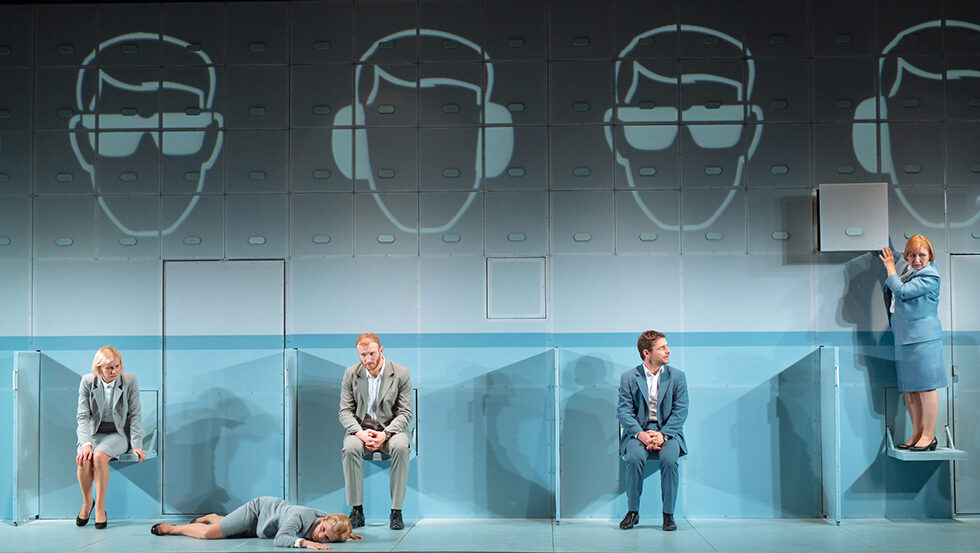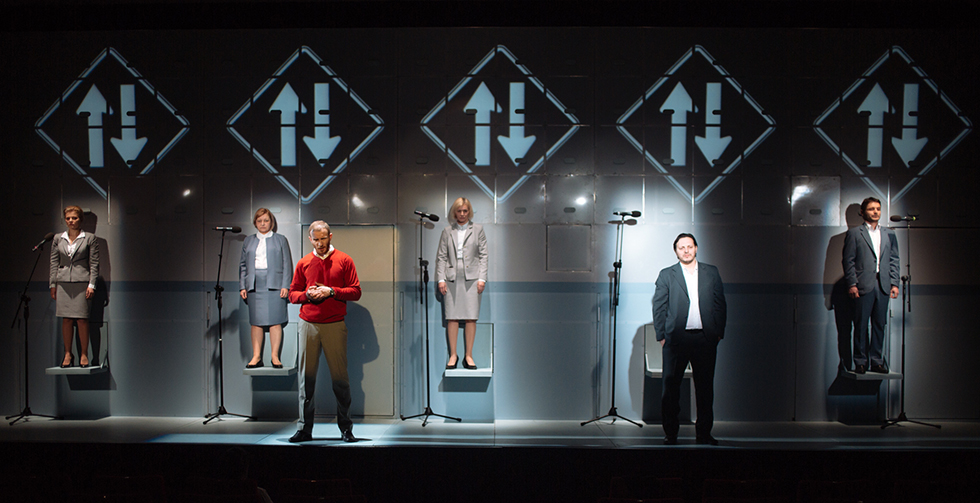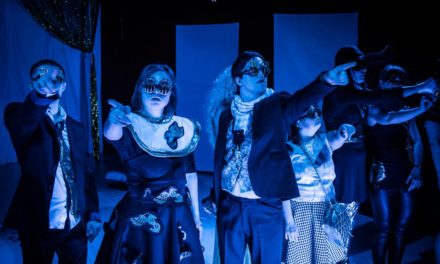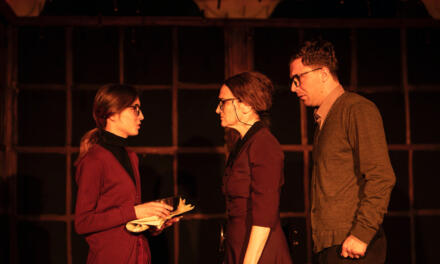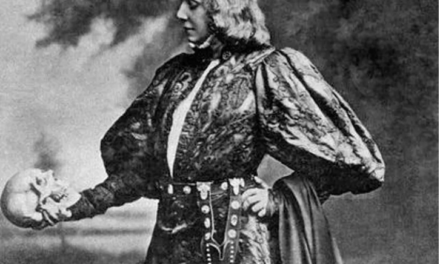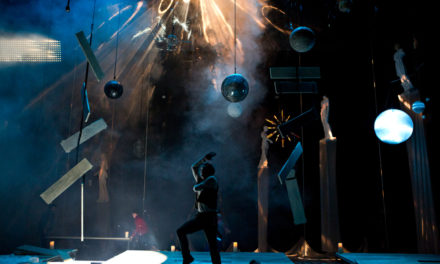A powerful trend in Romanian new drama in the past few years focuses on re-discovering of the recent past, a sort of expanded journalistic documentation on issues of vital interest for the development of the Romanian society. DramAcum movement (which translates as drama now/ instant drama/ and can be interpreted as “theater of urgency”) was launched in 2002 and it emerged from the National University for Theater and Film in Bucharest. Issues like homelessness, racism against the gypsy population, inter-ethnic conflicts, but also perennial problems like emmigration, the generation gap, relationship between power and politics, are the focus of most dramAcum related productions. Step by step, the young Romanian artists are drawing the country’s map on stage so that Romanian contemporary society could be seen through performance lens, as it happened for example in the British contemporary theater where playwrights “rewrote the nation” (Aleks Sierz, 2010)
The most influential among these young artistic personalities is playwright and director Gianina Cărbunariu. Her approach to controversial issues post-1990s has became her signature style. After her debut in school, Cărbunariu wrote Stop the Tempo and staged it in a small fringe theater – Monday Theater at Green Hours Café (it premiered in December 2003). Stop the Tempo – had the simplest and yet the smartest staging ideas – in a complete darkness, three performers armed only with lanterns were moving around between spectators, speaking with flashes on their faces, verbalizing the f frustration of the young generation forced to live in a society obsessed with consumption and greed, confronted with a lack of true moral and cultural values. Stop the Tempo was considered the manifesto of 2000 generation in Romania, a generation composed out of people who were educated and started their careers after 1990. The play toured and was eventually staged in many European countries, impacting many young people as it gave a voice to a universal need of the youngsters to change the world.
Other productions signed by Cărbunariu were 20/20, a piece about the ethnic clashes that took place in March 1990 between Romanians and Hungarians in the Transylvanian city of Tg. Mures, and Sold Out, which focused on the “selling” of the German citizens from Romania to the German state in the 1970s and 1980s, up to just before the Romanian Revolution. Another production, awarded by the international jury of New Romanian Drama Festival in 2011 as the Best Production Based on New Romanian drama, Red Mountain/politically and physically was a co-production of dramAcum and a state-financed theater, the Hungarian Theater in Cluj. Red Mountain is one of the most controversial subjects debated in Romanian mass-media in the last couple of years – a case of long-awaited Government approval for gold mining in Romanian mountains. The issue has high-level political implications, and it has involved years of press campaigns, accusations of corruption, NGO activism with European funds – a case that Romanian Government has failed to solve yet and about which there are still many things to be unveiled. Due to all the controversies, it was really courageous for the dramAcum team formed out of Gianina Cărbunariu, Andrea Vălean, Radu Apostol (directors), Peca Ștefan, Andu Dumitrescu (video), Florin Fieroiu (choreography), Bogdan Burlăcianu (music) and actors Cristina Toma, Csilla Albert, Andras Buzasi, Lorand Farkas, Csongor Kollo, Levente Molnar to discuss such an issue on stage. The text was written by Peca Ștefan, Gianina Cărbunariu and Andrea Vălean. The scenes of the show were rehearsed separately by each of the three directors. The documentation for the production took place in the village called Red Mountain, with the entire creative team being involved in it.
The interviews the team made with local people and representatives of the corporation which, of course, is fighting for the exploitation of the place were not enough to clear up all the aspects of the problem, as one of the actresses said in one of the discussions after the show. Sometimes, preserving the doubt is most essential, especially when it comes to a show that doesn’t aim to provide all answers to the questions related to this subject, but merely to bring these questions forward to the open public debate. The placement of the set-design elements and spectators around the performing space was meant to create a sense of implication for the audience, spectators being included in the dramaturgy of the show, as in the end some of them are asked to read a letter some of the characters received.
The objects one can see on stage match those in the houses visited by the team while documenting the case in Red Mountain – a television set on which one can see only electoral promotional clips, a red microwave, or small replicas of the key-monuments from the Red Mountain, all of them displayed on high pedestals with a stream of light on them, as if exhibited in a strange museum from the 1980s. Red Mountain has an intriguing kaleidoscopic structure which instead of confirming old formulas, opens up towards new paths. The show is open-ended with the spectators left alone on stage, reading letters, being the performers, an end well fit for the unfinished business of Red Mountain gold exploitation.
Another production signed in December 2011 by Cărbunariu, X mm from Y km, was generated by her research in the archives of the Romanian Secret Police, called “Securitate” before 1989. She chose a nine pages document, a proof of a discussion between the Romanian dissident Dorin Tudoran and the representatives of Securitate and the Romanian Writers’ Guild who tried to convince him to give up his wish to leave the country. Cărbunariu takes a decisive leap beyond the realistic scheme and decides to replay a couple of scenes with different acting solutions, as if trying hard to recompose a puzzle. As nobody really knows how this meeting really went, and how did the participants behave, she tries a couple of versions for each key scene introduced by the words “I Replay.” In an essay documenting her research and working process published by Romanian performing arts magazine Scena.ro Cărbunariu underlines the importance of this mechanism: “The replayed scenes are at stake in the performance, they are the ‘translation’ with theatrical means of the sensation of moving sands that I felt facing all those words.”
In X mm from Y km actors are free to stop whenever they feel they need and they can exchange the roles between them. Two women and two men are playing the three men identified as the participants; in each configuration, one of the actors has to play the part of “the anonymous eye,” the person who wrote down what was said that day. Here, “the eye” is a camera with images projected on the two walls of the studio. The four actors thus function like an “apparatus” meant to reproduce from all angles an episode. The concept of the production operates as an intentional reduction which in actuality, intensifies the researched issue. It proposes different frames of interpretation of the power relationships of that time, seen from a contemporary analytical perspective. In other words, it brings about “a reframing of material and symbolic space. And it is in this way that art bears upon politics.” (Rancière, 2009:24). Directorial choices like keeping the audience in darkness and using lanterns to enhance the symbolic power of the actors as well as the open endings of her productions, allows Cărbunariu to “disrupt the relationship among the visible, the sayable and the thinkable without having to use the terms of a message as a vehicle.” (Rancière, 2004: 63).
In her latest project, Common People (2015), Cărbunariu interrogates the relationship between surveillance and whistleblowers:
In a time where austerity measures are taken and the old systems are confronting new challenges, there are few people who don’t hesitate to express their way of thinking. Faciani or Snowden are the cases more discussed by the international media. If we search through local press there are people who are denouncing irregularities in many fields of our society. Recent psychological and sociological studies focus on this profile roughly laid down as: an ordinary person, hired in a state or private system, decides to make public irregularities of this system, due to moral values he/she adheres to. The project “Common People” aims to research through interviews with whistleblowers from different countries, to create a fictional work based on our meeting with these people and with their stories and to open public discussions with the audiences participating at the event.
Cărbunariu is the first in her generation to introduce the idea that she was guided in her work by ethical values rather than aesthetics: “Very early in the rehearsals questions emerged about how could we approach this issue, this material, these “characters” (real people like us) and how could we deal with the audience? These are questions which are connected not only to the aesthetics of the performance, but in the same degree they are connected with its ethics.”
[1] Sierz explains that ”by articulating the concerns of various tribes, British playwrights are deeply involved in the project of writing and rewriting the nation”
[2] Monday Theater at Green Hours Café had the same role in Romanian theater like Café Cino in New York for the birth of off-Broadway movement, as many other young Romanian directors staged here their first shows after school.
Adapted from the New Theatre Quarterly theater magazine (November 2013). Reposted with permission of the author.
This post was written by the author in their personal capacity.The opinions expressed in this article are the author’s own and do not reflect the view of The Theatre Times, their staff or collaborators.
This post was written by Cristina Modreanu.
The views expressed here belong to the author and do not necessarily reflect our views and opinions.

